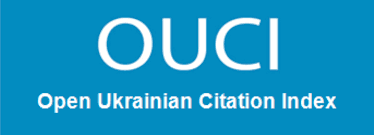Download full text in PDF
Markiv VS, Petrushka BM, Khomenchuk VO, Kurant VZ. Dynamics of fatty acid composition in the muscles of crucian carp and pike under the influence of elevated concentrations of cobalt ions. Bìol Tvarin. 2025; 27 (3): 61–67. DOI: 10.15407/animbiol27.03.061.
https://doi.org/10.15407/animbiol27.03.061
Received 20.08.2025 ▪ Revision 30.09.2025 ▪ Accepted 10.10.2025 ▪ Published online 22.10.2025
Dynamics of fatty acid composition in the muscles of crucian carp and pike under the influence of elevated concentrations of cobalt ions
V. S. Markiv, B. M. Petrushka, V. O. Khomenchuk, V. Z. Kurant
This email address is being protected from spambots. You need JavaScript enabled to view it.
Ternopil Volodymyr Hnatiuk National Pedagogical University, 2 Maxyma Kryvonosa str. Ternopil, 46027, Ukraine
In today’s conditions of growing anthropogenic pressure on aquatic ecosystems, the problem of heavy metal accumulation, including cobalt ions, is becoming particularly relevant. Cobalt ions can enter aquatic environments as a result of mining activities, metallurgy, and the production of batteries, dyes, catalysts, and magnetic materials. It is collectively may lead to local exceedances of permissible concentration limits in freshwater ecosystems. Despite the fact that cobalt is a biogenic element in low concentrations, its excess has a toxic effect on hydrobionts, in particular affecting lipid homeostasis. One of the sensitive indicators of metabolic disorders in fish is a change in the fatty acid composition of tissues, which can be used as a bioindicator of toxic pressure and the functional state of the organism. The paper analyses changes in the fatty acid composition of the muscle tissue of crucian carp (Carassius gibelio Bloch) and pike (Esox lucius L.) under the influence of cobalt ions at concentrations of 0.1 mg/dm³ and 0.25 mg/dm³ over a period of 14 days. These concentrations correspond to 2 and 5 maximum permissible concentrations. Total lipids were extracted and transesterified to obtain fatty acid methyl esters, which were then analyzed by gas chromatography for the quantitative determination of individual fatty acids. In crucian carp, the influence of cobalt ions led to significant changes in the composition of essential fatty acids. In particular, the fractions of saturated myristic acid (14:0) and long-chain monounsaturated eicosenoic acid (20:1) increased proportionally to the concentration of the investigated metal, while the levels of stearic acid (18:0) and oleic acid (18:1) decreased. A more systematic effect was observed in pike muscles: the content of many saturated fatty acid fractions decreased compared to the control group, while changes in the proportions of key polyunsaturated fatty acids likely indicate impaired desaturase activity. In the pike organism, a more systemic effect of cobalt ions was observed, which consisted in a tendency to decrease the amount of most saturated fatty acids. Some nutritional indices for assessing fatty acids were also analyzed.
Key words: fishes, fatty acids, defense system, physiological response, regulation, adaptive reactions, biomonitoring, toxic pollution, cobalt
- Adam AC, Lie KK, Moren M, Skjærven KH. High dietary arachidonic acid levels induce changes in complex lipids and immune-related eicosanoids and increase levels of oxidised metabolites in zebrafish (Danio rerio). Br J Nutr. 2017; 117 (8): 1075–1085. DOI: 1017/S0007114517000903.
- Ahmed I, Jan K, Fatma S, Dawood MAO. Muscle proximate composition of various food fish species and their nutritional significance: A review. J Anim Physiol Anim Nutr. 2022; 106 (3): 690–719. DOI: 1111/jpn.13711.
- Banfalvi G. Biological membranes. In: Banfalvi G. Permeability of Biological Membranes. Springer Cham, 2016: 1–71. ISBN 978-3-319-28096-7. DOI: 1007/978-3-319-28098-1_1.
- Bejaoui S, Chetoui I, Ghribi F, Belhassen D, Abdallah BB, Fayala CB, Boubaker S, Mili S, Soudani N. Exposure to different cobalt chloride levels produces oxidative stress and lipidomic changes and affects the liver structure of Cyprinus carpio Environ Sci Pollut Res. 2024; 31: 51658–51672. DOI: 10.1007/s11356-024-34578-y.
- Blust R. 6 — Cobalt. Fish Physiology. 2012; 31 (A): 291–326. DOI: 1016/S1546-5098(11)31006-0.
- Calder PC. Eicosanoids. Essays Biochem. 2020; 64 (3): 423–441. DOI: 1042/EBC20190083.
- Calder PC. Functional roles of fatty acids and their effects on human health. J Parenter Enter Nutr. 2015; 39 (1S): 18S–32S. DOI: 1177/0148607115595980.
- Calder PC. Polyunsaturated fatty acids and inflammation. Biochem Soc Trans. 2005; 33 (2): 423–427. DOI: 1042/BST0330423.
- Chen J, Liu H. Nutritional indices for assessing fatty acids: A mini-review. Int J Mol Sci. 2020; 21 (16): 5695. DOI: 3390/ijms21165695.
- Chetoui I, Ghribi F, Bejaoui S, Belhassen D, Baati R, Soudani N. Impact of cobalt levels on fatty acid profile and nutritional quality of common carp muscle (Cyprinus carpio). Lipids. 2025. DOI: 1002/lipd.12449.
- Christie WW, Han X. Chapter 7 — Preparation of derivatives of fatty acids. In: Christie WW, Han X. Lipid Analysis (Fourth edition): Isolation, Separation, Identification and Lipidomic Analysis. Oily Press Lipid Library Series, Woodhead Publishing, 2012: 145–158. ISBN 978-095-525-12-45. DOI: 1533/9780857097866.145.
- Das D, Das P, Moniruzzaman M, Poddar Sarkar M, Mukherjee J, Chakraborty SB. Consequences of oxidative damage and mitochondrial dysfunction on the fatty acid profile of muscle of Indian Major Carps considering metal toxicity. Chemosphere. 2018; 207: 385–396. DOI: 1016/j.chemosphere.2018.05.108.
- DeGrazia D, Beauchamp TL. Principles of Animal Research Ethics. New York, Oxford Academic, 2020: 5–42. DOI: 1093/med/9780190939120.003.0001.
- Duarte B, Carreiras J, Pérez-Romero JA, Mateos-Naranjo E, Redondo-Gómez S, Matos AR, Marques JC, Caçador I. Halophyte fatty acids as biomarkers of anthropogenic-driven contamination in Mediterranean marshes: Sentinel species survey and development of an integrated biomarker response (IBR) index. Ecol Indic. 2018; 87: 86–96. DOI: 1016/j.ecolind.2017.12.050.
- Erdoğrul Ö, Erbilir F. Heavy metal and trace elements in various fish samples from Sır Dam Lake, Kahramanmaraş, Turkey. Environ Monit Assess. 2006; 130 (1–3): 373–379. DOI: 1007/s10661-006-9404-5.
- Ernst R, Ejsing CS, Antonny B. Homeoviscous adaptation and the regulation of membrane lipids. J Mol Biol. 2016; 428 (24A): 4776–4791. DOI: 1016/j.jmb.2016.08.013.
- European Convention for the Protection of Vertebrate Animals used for Experimental and other Scientific Purposes. Strasbourg: Council of Europe; 1986. Available at: https://rm.coe.int/168007a67b
- Fadhlaoui M, Couture P. Combined effects of temperature and metal exposure on the fatty acid composition of cell membranes, antioxidant enzyme activities and lipid peroxidation in yellow perch (Perca flavescens). Aquat Toxicol. 2016; 180: 45–55. DOI: 1016/j.aquatox.2016.09.005.
- Fadhlaoui M, Pierron F, Couture P. Temperature and metal exposure affect membrane fatty acid composition and transcription of desaturases and elongases in fathead minnow muscle and brain. Ecotoxicol Environ Saf. 2018; 148: 632–643. DOI: 1016/j.ecoenv.2017.10.040.
- Folch J, Lees M, Sloane Stanley G. A simple method for the isolation and purification of total lipids from animal tissues. J Biol Chem. 1957; 226 (1): 497–509. DOI: 1016/S0021-9258(18)64849-5.
- Galindo A, Garrido D, Monroig Ó, Pérez JA, Betancor MB, Acosta NG, Kabeya N, Marrero MA, Bolaños A, Rodríguez C. Polyunsaturated fatty acid metabolism in three fish species with different trophic level. Aquaculture. 2021; 530: 735761. DOI: 1016/j.aquaculture.2020.735761.
- Helczman M, Tomka M, Arvay J, Tvrda E, Andreji J, Fik M, Snirc M, Jambor T, Massanyi P, Kovacik A. Selected micro- and macro-element associations with oxidative status markers in common carp (Cyprinus carpio) blood serum and ejaculate: A correlation study. J Toxicol Environ Health A. 2024; 87 (24): 999–1014. DOI: 1080/15287394.2024.2406429.
- Jovičić K, Djikanović V, Santrač I, Živković S, Dimitrijević M, Vranković J. Content of fatty acids in relation to the metal concentration in the muscle of two freshwater fish species. Preprints. 2023: 2023071947. DOI: 20944/preprints202307.1947.v1.
- Jovičić K, Djikanović V, Santrač I, Živković S, Dimitrijević M, Vranković JS. Effects of trace elements on the fatty acid composition in Danubian fish species. Animals. 2024; 14 (6): 954. DOI: 3390/ani14060954.
- Jovičić K, Janković S, Nikolić DM, Đikanović V, Skorić S, Krpo-Ćetković J, Jarić I. Prospects of fish scale and fin samples usage for nonlethal monitoring of metal contamination: A study on five fish species from the Danube River. Knowl Manag Aquat Ecosyst. 2023; 424: 4. DOI: 1051/kmae/2022027.
- Kates M. Techniques of Lipidology: Isolation, Analysis and Identification of Lipids. Amsterdam, North-Holland Publishing Company, 1972: 342 p. DOI: 1016/S0075-7535(08)70544-8.
- Kovacik A, Helczman M, Arvay J, Jambor T, Kovacikova E. Toxic elements and fatty acid composition in the freshwater fish family Cyprinidae (Rafinesque 1815): Balancing nutritional benefits and health risks. Environ Monit Assess. 2025; 197: 676. DOI: 1007/s10661-025-14112-4.
- Laurent J, Le Grand F, Bideau A, Le Berre I, Le Floch S, Pichereau V, Laroche J. Fatty acid analysis in an estuarine fish species to assess the health status of hydrosystems impacted by eutrophication and multistress. Estuar Coast Shelf Sci. 2025; 319: 109279. DOI: 1016/j.ecss.2025.109279.
- Linhartová Z, Krejsa J, Zajíc T, Másílko J, Sampels S, Mráz J. Proximate and fatty acid composition of 13 important freshwater fish species in central Europe. Aquac Int. 2018; 26 (2): 695–711. DOI: 1007/s10499-018-0243-5.
- Łuczyńska J, Paszczyk B, Nowosad J, Łuczyński M. Mercury, fatty acids content and lipid quality indexes in muscles of freshwater and marine fish on the Polish market. Risk assessment of fish consumption. Int J Environ Res Public Health. 2017; 14 (10): 1120. DOI: 3390/ijerph14101120.
- Łuczyńska J, Paszczyk B. Health risk assessment of heavy metals and lipid quality indexes in freshwater fish from lakes of Warmia and Mazury region, Poland. Int J Environ Res Public Health. 2019; 16 (19): 3780. DOI: 3390/ijerph16193780.
- Lushchak VI. Contaminant-induced oxidative stress in fish: A mechanistic approach. Fish Physiol Biochem. 2016; 42 (2): 711–747. DOI: 1007/s10695-015-0171-5.
- Mahboob S, Al-Ghanim KA, Al-Misned F, Shahid T, Sultana S, Sultan T, Hussain B, Ahmed Z. Impact of water pollution on trophic transfer of fatty acids in fish, microalgae, and zoobenthos in the food web of a freshwater ecosystem. Biomolecules. 2019; 9 (6): 231. DOI: 3390/biom9060231.
- Nasri F, Heydarnejad S, Nematollahi A. Sublethal cobalt toxicity effects on rainbow trout (Oncorhynchus mykiss). Croat J Fish. 2019; 77 (4): 243–252. DOI: 2478/cjf-2019-0018.
- Nędzarek A, Formicki K, Kowalska-Góralska M, Dobrzański Z. Concentration and risk of contamination with trace elements in acipenserid and salmonid roe. J Food Compos Analys. 2022; 110: 104525. DOI: 1016/j.jfca.2022.104525.
- Özden Ö, Erkan N, Kaplan M, Karakulak FS. Toxic metals and omega-3 fatty acids of Bluefin Tuna from aquaculture: Health risk and benefits. Expo Health. 2020; 12 (1): 9–18. DOI: 1007/s12403-018-0279-9.
- Poorani R, Bhatt AN, Dwarakanath BS, Das UN. COX-2, aspirin and metabolism of arachidonic, eicosapentaenoic and docosahexaenoic acids and their physiological and clinical significance. Eur J Pharmacol. 2016; 785: 116–132. DOI: 1016/j.ejphar.2015.08.049.
- Saito H, Aono H. Characteristics of lipid and fatty acid of marine gastropod Turbo cornutus: High levels of arachidonic and n-3 docosapentaenoic acid. Food Chem. 2014; 145: 135–144. DOI: 1016/j.foodchem.2013.08.011.
- Santos AL, Preta G. Lipids in the cell: Organisation regulates function. Cell Mol Life Sci. 2018; 75 (11): 1909–1927. DOI: 1007/s00018-018-2765-4.
- Shahjahan M, Taslima K, Rahman MS, Al-Emran M, Alam SI, Faggio C. Effects of heavy metals on fish physiology — A review. Chemosphere. 2022; 300: 134519. DOI: 10.1016/j.chemosphere.2022.134519.
- Sherratt SC, Juliano RA, Copland C, Bhatt DL, Libby P, Mason RP. EPA and DHA containing phospholipids have contrasting effects on membrane structure. J Lipid Res. 2021; 62: 100106. DOI: 1016/j.jlr.2021.100106.
- Silva CO, Simões T, Novais SC, Pimparel I, Granada L, Soares AMVM, Barata C, Lemos MFL. Fatty acid profile of the sea snail Gibbula umbilicalis as a biomarker for coastal metal pollution. Sci Total Environ. 2017; 586: 542–550. DOI: 1016/j.scitotenv.2017.02.015.
- Strandberg U, Palviainen M, Eronen A, Piirainen S, Laurén A, Akkanen J, Kankaala P. Spatial variability of mercury and polyunsaturated fatty acids in the European perch (Perca fluviatilis) — Implications for risk-benefit analyses of fish consumption. Environ Pollut. 2016; 219: 305–314. DOI: 1016/j.envpol.2016.10.050.
- Stubblefield WA, Van Genderen E, Cardwell AS, Heijerick DG, Janssen CR, De Schamphelaere KA. Acute and chronic toxicity of cobalt to freshwater organisms: Using a species sensitivity distribution approach to establish international water quality standards. Environ Toxicol Chem. 2020; 39 (4): 799–811. DOI: 1002/etc.4662.
- Sun S, Ren T, Li X, Cao X, Gao J. Polyunsaturated fatty acids synthesized by freshwater fish: A new insight to the roles of elovl2 and elovl5 in vivo. Biochem Biophys Res Commun. 2020; 532 (3): 414–419. DOI: 1016/j.bbrc.2020.08.074.
- Van Dael P. Role of n-3 long-chain polyunsaturated fatty acids in human nutrition and health: Review of recent studies and recommendations. Nutr Res Pract. 2021; 15 (2): 137–159. DOI: 4162/nrp.2021.15.2.137.
- Vieira AF, Xatse MA, Murray SY, Olsen CP. Oleic acid metabolism in response to glucose in elegans. Metabolites. 2023; 13 (12): 1185. DOI: 10.3390/metabo13121185.
- Whelan J, Fritsche K. Linoleic Acid. Adv Nutr. 2013; 4 (3): 311–312. DOI: 3945/an.113.003772.
- Yang X, Sheng W, Sun GY, Lee JCM. Effects of fatty acid unsaturation numbers on membrane fluidity and α-secretase-dependent amyloid precursor protein processing. Neurochem Int. 2012; 58 (3): 321–329. DOI: 1016/j.neuint.2010.12.004.
- Zhang X, Ning X, He X, Sun X, Yu X, Cheng Y, Yu RQ, Wu Y. Fatty acid composition analyses of commercially important fish species from the Pearl River Estuary, China. PLoS ONE. 2020; 15 (1): e0228276. DOI: 1371/journal.pone.0228276.














